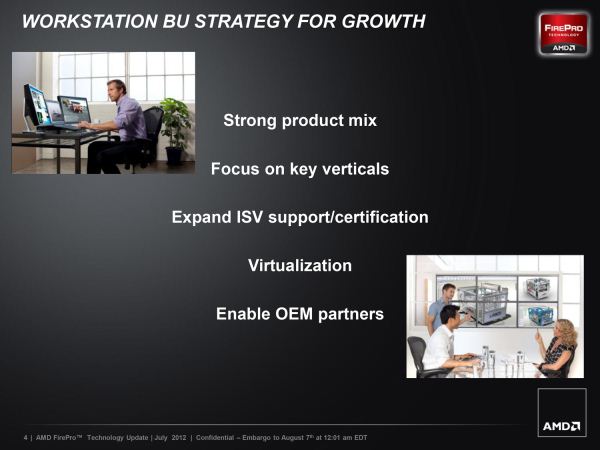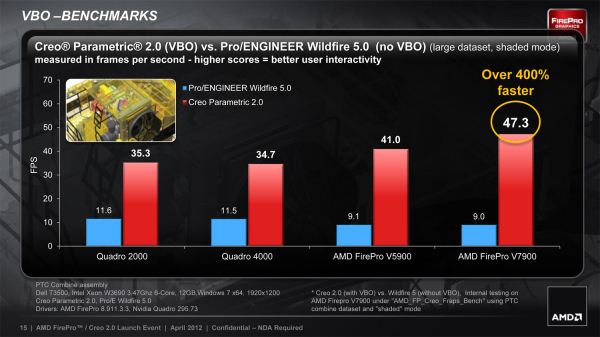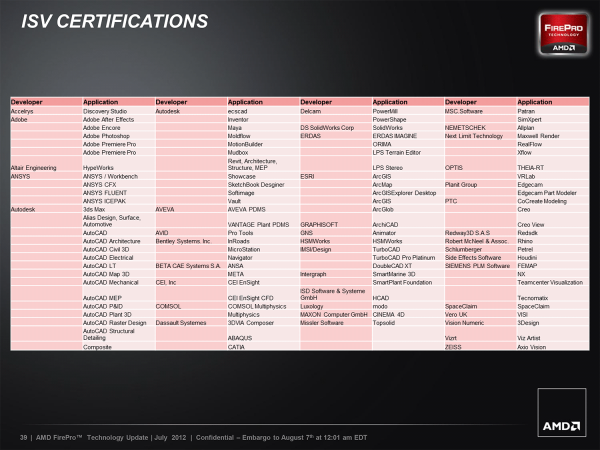The AMD FirePro W9000 & W8000 Review: Part 1
by Ryan Smith on August 14, 2012 4:00 AM ESTAMD’s Plan of Attack
So how does AMD take back a larger share of the professional graphics market? The short answer is that there is no easy solution.
Traditionally AMD has underpriced NVIDIA on comparable hardware, and while that’s easy to do it only works to a certain extent, as showcased by AMD’s continuing sub-20% market share.
Professional graphics buyers, as it turns out, are not nearly as sensitive to price as consumers, particularly when it comes to something as relatively cheap as a video card. Depending on the job at hand a video card may be a fraction of the cost of lost time, so if buyers believe they’re getting something that is going to be more compatible or more reliable, then they can usually justify the additional cost for what’s roughly the same level of performance.
This is not to say that AMD’s products are unreliable or incompatible, but it means that for the professional graphics market perception is reality. And that perception is largely being driven by NVIDIA, who by all accounts is extremely good at product marketing and promotion and combining that marketing message with solid products. Even if AMD has a superior product they still need to counter NVIDIA’s marketing and their momentum, and that can’t be accomplished just by beating NVIDIA’s price/performance ratio.
As a result AMD has had to learn to play NVIDIA’s game. Realistically, AMD can’t match NVIDIA’s marketing muscle right away (this is where having all the profits confers an advantage), but they can match elements of NVIDIA’s winning strategy.
The first most important part of that strategy is to continue to improve their validation and certification process. Most of their customers are buying professional video cards to run very specific and very important applications like AutoCAD, Creo Parametric, CINEMA 4D, and of course Adobe’s Creative Suite. They aren’t necessarily using AMD’s products because they particularly like AMD, but rather because provides the best tool for the job. As a result ISV certifications are essential here, which requires AMD to be proactive in reaching out to ISVs and quick to fix any bugs keeping them from being certified. The more software they can get certified, the wider the market they can sell to.
As AMD has learned however, being proactive doesn’t just mean getting ISV certification, but also directly working with those ISVs. NVIDIA’s work with Adobe on the Mercury Playback Engine for Adobe Premiere Pro CS5 not only earned a lot of press for NVIDIA, but it made their Quadro cards the product to get for serious Premiere users. A well planned partnership will benefit both partners, with the ISV gaining the experience of the GPU vendor and the GPU vendor gaining sales from the users of that software.
To that end, AMD’s big partnership right now is with PTC, who is responsible for a number of CAD programs including Creo Parametric. Like most professional software ISVs, PTC has taken a very conservative stance towards adopting new technologies, meaning their software is slow to make use of new GPU features. In a move similar to NVIDIA’s Adobe partnership, AMD has formed a partnership with PTC to improve Creo Parametric in return for exclusive feature rights for a time.
AMD has implemented Vertex Buffer Object (VBO) support and Order Independent Transparency (OIT) support in Cero Parametric, greatly speeding up the software in some cases. In return AMD has a 1 year exclusive on OIT functionality, which means that users who want to take advantage of it would need to use AMD video cards. Whether this partnership will significantly benefit AMD remains to be seen, but at the very least it’s exactly the kind of thing they need to be doing to improve their standing and their sales in the professional graphics community.
Of course ISVs are not the only partners a GPU vendor wants to have, as on the other end of the spectrum you have the hardware. Professional graphics customers buy hardware based on its performance and compatibility with the applications they use, but those same customers are generally looking to buy entire systems, not individual video cards. This makes OEM partnerships the other important partnership for AMD to work on.
AMD already regularly works with OEMs in order to integrate their consumer products, so this generally isn’t a matter of forging new partnerships, but rather making the best use of the partnerships they already have. Here AMD needs to approach OEMs in order to get their FirePro cards certified in the appropriate workstation models, and then actually land design wins for those products. For the W series AMD has already certified with and landed design wins with both Dell and HP. Specifically AMD has design wins with both companies for the W5000 and W7000, while they also have a design win with Dell on the W8000. Meanwhile the W9000 isn’t up for any design wins due to its very high price and low volume, but AMD has told us that they have the option of paying for certification themselves, at which point it would be offered as an optional upgrade for equally high-end workstations.
Bringing things to a close, AMD’s plan of attack has one final plank: compute & OpenCL evangelism. AMD likes to say that they’ve bet the company on OpenCL, and while that’s a bit exaggerated it isn’t too far from the truth. Compute performance is an important aspect of the professional graphics market (NVIDIA has proven that much), and because NVIDIA has their own proprietary compute API it’s not enough for AMD to just have good compute performance – they need to actually convince developers to use OpenCL as opposed to CUDA.
This has been an ongoing process for AMD, and unfortunately it’s one where it’s hard to gauge the results. Over the years AMD has introduced a number of new tools for OpenCL development, and though OpenCL is an open standard officially controlled by the Khronos consortium, in the public eye AMD is by far the most active proponent of OpenCL.
At this point in time AMD believes they’ve finally turned the corner on OpenCL, both in terms of general adoption and in eating into CUDA’s marketshare. Technically speaking OpenCL adoption is always increasing, but the lag time can be quite long between when an ISV announces they’ll be using it and when they actually release products that meaningfully use it. Only in the last year or so have products making meaningful use of it finally shipped, including the Adobe Creative Suite and various Autodesk products. This mirrors a general trend we’ve been seeing on the consumer desktop, where applications like WinZip and Handbrake are also finally making meaningful use of OpenCL.
As for stealing market share from NVIDIA’s CUDA, that ends up being a bit more nebulous. Research by 3rd party firms such as Evans Data Corp has OpenCL already beating CUDA, but because we don’t have access to the details of that research there’s not a lot we can say there. Programming language & API usage has always been difficult to estimate since it requires developers to volunteer information, which is good enough for measuring general trends but is often not good enough for measuring specific numbers. AMD has certainly turned some CUDA developers over to OpenCL, but judging from their respective conferences (GTC and AFDS) and the presentations given, CUDA is still alive and well, and it’s by no means clear as to whether OpenCL has overtaken CUDA. But much like the overall OpenCL adoption rate this is clearly improving.
Finally, it goes without saying that while software, tools, and marketing play a big part of AMD’s OpenCL strategy, hardware is quite often the biggest part of the equation. To that end AMD will be the first to tell you that their previous VLIW architecture wasn’t particularly well suited for compute tasks. VLIW could do very, very well in true brute force operations (e.g. password cracking), but more complex programs mapped poorly to the underlying architecture. So developers looking to write complex compute applications would often find themselves writing for NVIDIA hardware, at which point there’s a strong incentive to write those programs in CUDA In the first place.
The solution to that problem was for AMD to turn to an entirely different architecture, which was introduced last year as Graphics Core Next. For AMD GCN provides the final piece of the puzzle, bringing together all of their other efforts with a high performance compute architecture. With GCN AMD can finally offer the hardware necessary to rival NVIDIA’s own compute performance, which in turn makes OpenCL more attractive to developers even if they aren’t necessarily intending to target AMD’s hardware right away, as it’s now a viable alternative.













35 Comments
View All Comments
ManuelLP - Thursday, August 30, 2012 - link
When is publish the second part? Tomorrow is the end of the month.Gadgety - Wednesday, December 19, 2012 - link
This very interesting part I was done back in August. It's now December. I've searched for W9000 on Anandtech but no part II shows up. What gives?nitro912gr - Friday, January 18, 2013 - link
Where is PART 2?theprofessionalschoice - Thursday, December 5, 2013 - link
As an entrepreneur in Bitcoin mining, I have made roughly $1.7m. from a start-up fund of only $40,000. I can personally vouch for the W9000 cards because I've mined with them exclusively and now happily manage a small empire because of their vast throughput. Kudos to the author for going so in-depth with this review... VERY accurate and I highly recommend this card to miners of any level... I can't wait for the 20nm dual-chips to launch (exclusively in the new Mac Pro) sometime this month!!! Great professional cards - NOT for consumers! ;)ballsystemlord - Wednesday, October 30, 2019 - link
I guess we'll never see part 2... :(Really, I am curious.